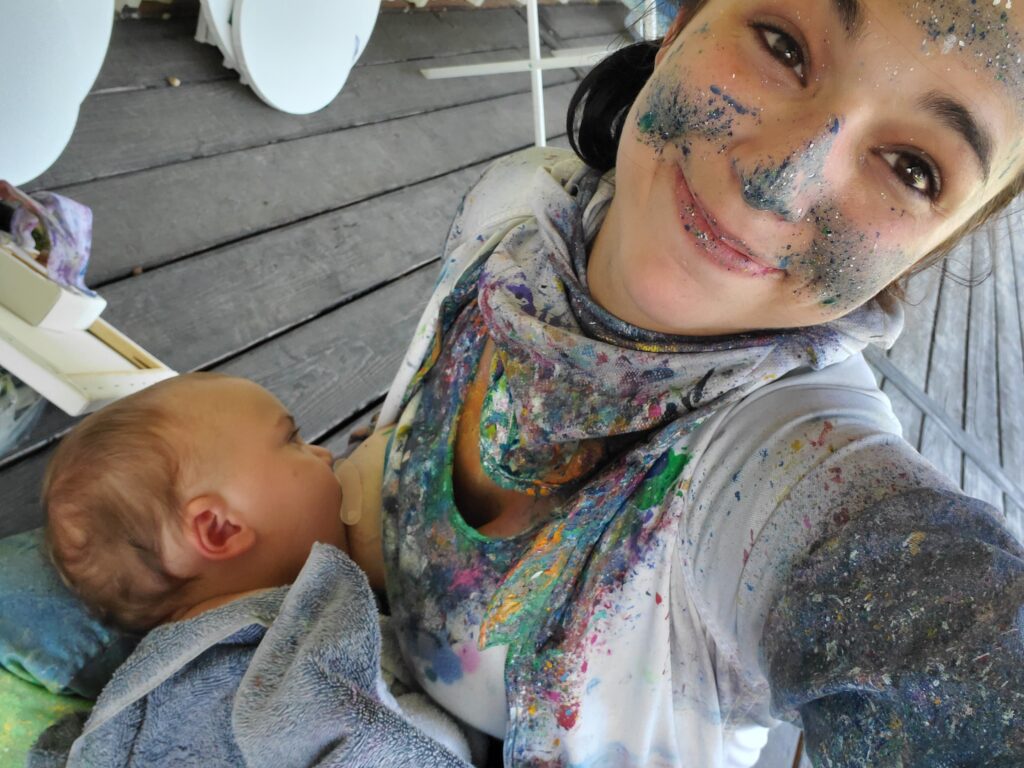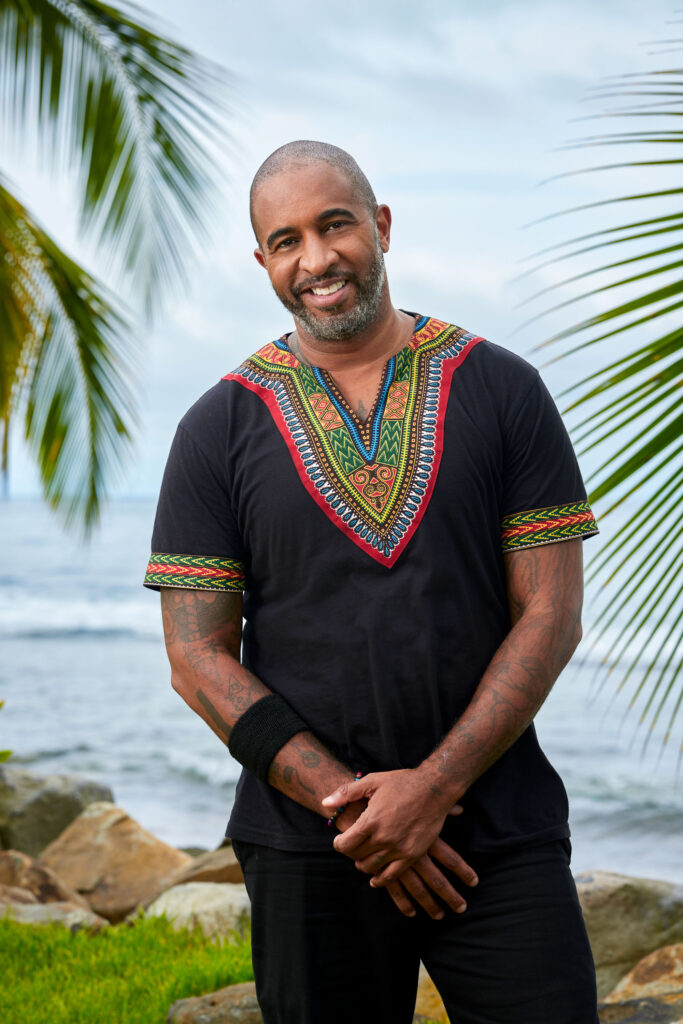
Amber Kraatz is an emerging artist in the DFW area. She received a BFA in Studio Art at University of North Texas. She works primarily with Oils and Acrylics and Occasionally in sculpting, drawing, and photography. Originally starting as a hyper realistic painter, she has since transitioned into a more abstract aesthetic. Portraiture, however, has remained a constant in her work. Amber finds inspiration in the figure, both in physical and psychological characteristics and uses it as a foundation to break down and abstract.
Did you like drawing at an early age?
Yeah, I was always drawing. You typically assume whatever interest a kid is into, that’s their life goal. I think I was slightly above average with drawing, so my five-year-old brain thought that it would be a great career. Around high school, when I started painting, there was a teacher that recommended to me to try acrylic pieces. I originally hated it, but this teacher told me to keep trying with that style. I tried oil paint, which can be a lot slower, so you have more time to just work with it. Blending is a lot easier with oil paint and that’s when it just clicked. I now usually do a base layer of acrylics and then I throw down a bunch of layers, have them dry, throw down some more, and then I’ll finish on top with oil.
Were there any difficulties when it came to education after high school?
In high school, you have thoughts and plans that might not be super realistic. You think you’ll be going down a straight linear path and it’ll be perfect, but I ended up dropping out my first semester of college. I originally stopped going to classes and then started withdrawing officially. I want to say it was intentional that I took a couple of years off, but I just wasn’t ready to commit to anything as time consuming and expensive as college. Now saddled with debt, I felt lost and drifting, and for a while making art was the last thing on my mind. I began to look inward and stopped allowing opinions to dictate what I wanted to do. I decided that I would be going to a local community college and even dip my toes into various subjects. I took an art course and then of course I was like, “Oh man this is where the passion’s coming back.” This is what I really want to do. I just took art course after art course and realized this was my future career. I was at TCC for a couple years and then I transferred to UNT. It’s been a very long ride for normally a four-year degree, but I’ve had to mostly pay out of pocket and work at the same time. I feel I almost had an advantage just because I’ve had more time to develop my skill and figure out the type of style and aesthetic I want to go for. I don’t think I would’ve changed anything going back, but I’m here today and I learned a lot, and it’s good now.
Did the hyperrealism style start at UNT or was that always a part of your portfolio?
When I first started creating art, it was always representational or realistic. I think that’s just a jumping-off point for a lot of people because it’s easier to develop technical skills when you have an example of the finished product. It’s a little easier knowing what colors to mix and where to put it when you have a very clear angle in mind. In Tarrant County College, I went deep into this style and made stuff that would take me hours per session. I would be zooming in on pictures until you can only see pixels and basically start copying that on a canvas or whatever I was painting on. There was a point in undergraduate where the first few years is just building up technical skills and then you just get thrown into the wind where you paint whatever you want. You get feedback based on what you come up with but there’s no strict micromanagement. I was introduced to more abstraction and was feeling a little out of my comfort zone, because I didn’t know how to look at abstract pieces. I think a lot of the people that have untrained eyes can totally agree with me on this. I used to only see a bunch of paints splattered and didn’t understand how it could be worth so much. After more exposure, I started realizing what’s good and what’s bad. I think intention and understanding formal rules (and how to break them) plays a huge part in abstraction pieces. Whenever you start looking at this stuff a lot more, you can tell when a mark is intentional and when it’s just accidental. I think that’s advice I would give anyone, is that you shouldn’t be afraid to make bad paintings because you’re going to do it. Experimentation is a great source of learning and discovery. When I started dipping my toes into abstraction, my focus was about these moments of clarity. These moments of that’s obviously a leg or an elbow, but then it just turns into paint and then back into human form. Those are the parts that I found so much more satisfying and interesting than just copying a photo for me. It got to the point where painting directly from a reference phot, just felt like muscle memory. I could just kind of shut off my brain and just tediously paint this stuff. That’s why I change my style, and I think that’s why a lot of artists change their style over time, to still feel connected and challenged by their work.
Do you agree or disagree with a lot of criticisms towards modern and contemporary art?
It’s difficult to criticize art just because it’s so subjective. Something that is wonderful to one person is absolute garbage to another. I think just technique-wise, whenever someone looks at shapes on a canvas, and states, “Why is that here? My three-year-old can do that.” A response that I’ve heard before is, “Well, they didn’t do it.” It’s not exactly about the execution, but more about the concept behind it. This person did this first and it doesn’t matter if you could copy it because a lot of people could copy it. I do see work that’s sold for a lot of money and I feel like I could do that. But it’s the same thing, I didn’t do that and never came up with the original idea. I think it’s easy to look at the finished product and just disregard the process that goes into it, because usually the process is more challenging. It’s so much longer than what the final product really looks like.
What made you focus on the female anatomy in your artwork?
I had this Critique in undergrad that I feel really changed the path that my work went down. I was showing one of my more representational pieces and I remember my professor asking me questions that should have been simple but left me stumped. He asked, “Why are you painting this? What are you trying to say?” I couldn’t answer at the time, and it really opened my eyes to the desire to paint things that I’m interested in. I want to paint things that have meaning to me. I remember thinking, “I’m interested in gender, and I’m really interested in how it affects me personally.” That’s not a new concept, and it’s very oversaturated, but I was also told don’t paint what you think is boring or what you think is cliche. The first couple of paintings might be obvious or too on the nose, but once you stick with something long enough and you’re interested enough in it, then it takes on it’s own life. I really started doing these kinds of disfigured, disproportionate women’s bodies to analyze my own self. I feel on one side, I am my body and on the other side I am my mind. I feel those two trains of thoughts are sometimes in sync, but sometimes one overbalances the other. On certain occasions, it’s not even about what I think about myself, but what I think others think about me. Even though I use my own body as a reference for my paintings, I don’t think of them as self-portraits. I see it as a foundational tool to use as a jumping off point. I’ll exaggerate body parts that maybe I’m conscious of on myself, or I change the colors. And I think there’s a way that I connect with my body, but also disassociate with it. I’ll very much clarify some parts of the body, but then leave the face off like a way to distance myself, but also feel connected.
Do you work with models in these types of pieces?
Just me and sometimes my partner. I usually always start a piece with my journal and write down just any idea that comes to me. Most of them are bad and unusable. Occasionally I’ll forget what I write down and later have no idea where I was going with that line of thinking. I can look back and be like, “Okay, that could be interesting, I just need to change it a little bit.” It all starts on paper and then I sketch out a composition that I think is interesting. Sometimes it goes through a couple different compositions. It’s so funny because I always make these compositions of these bodies in almost impossible positions and then try to take pictures of myself in those positions and I can never quite move my body the way that I’m drawing these bodies. I’ll figure out the kind of color scheme I want to use, and then I start making the painting. I start with acrylic, throw down some layers, and then I’ll put oil paint on top and then just work like that.
Has the disconnection between mind and body been more prominent with the role of social media?
I think so. I mean when I was in high school Instagram wasn’t as big as it is now, but I can only imagine if it was. I was insecure enough and I’m sure everyone was insecure in high school and probably even now today. Having these images of these “idealized” bodies makes me realize that social media is something that I think we’re going to have to change or do something about in the future. I think it’s not beneficial to a lot of people’s mental health.
Is there anything else upcoming that you’re excited about with your portfolio?
I’m currently focusing on just adding more pieces to my portfolio. I’m just about to start sending out applications to graduate school. All the deadlines are coming up, so I’m kind of trying to paint as much as possible. Right now, I’m just focusing on getting my stuff in for that, but hopefully in the future, I will be in graduate school. I’m applying to primarily New York, so hopefully I’ll be up there.

